Integrated Professional Skills in the Digital Landscape Report
VerifiedAdded on 2023/01/11
|11
|3599
|44
Report
AI Summary
This report provides a comprehensive analysis of integrated professional skills in the digital age, comparing and contrasting the positive and negative impacts of online and offline presence for both individuals and businesses. It examines the benefits of online platforms for sales, communication, and skill development, while also addressing the associated drawbacks such as reduced profitability for businesses and online disinhibition for individuals. The report further explores the positive aspects of offline interactions, such as building relationships and ensuring privacy, and the negative aspects, including limitations on growth and learning opportunities. Additionally, it assesses the challenges and measures related to online security and privacy, including data management issues, the costs of maintaining privacy, human errors, and payment security, while also highlighting training, the use of VPNs, secure passwords, and two-factor authentication as crucial protective measures. The report concludes by emphasizing the importance of a balanced approach, integrating both online and offline strategies while prioritizing security and privacy.

Integrated Professional Skills
in the Digital Age
in the Digital Age
Paraphrase This Document
Need a fresh take? Get an instant paraphrase of this document with our AI Paraphraser
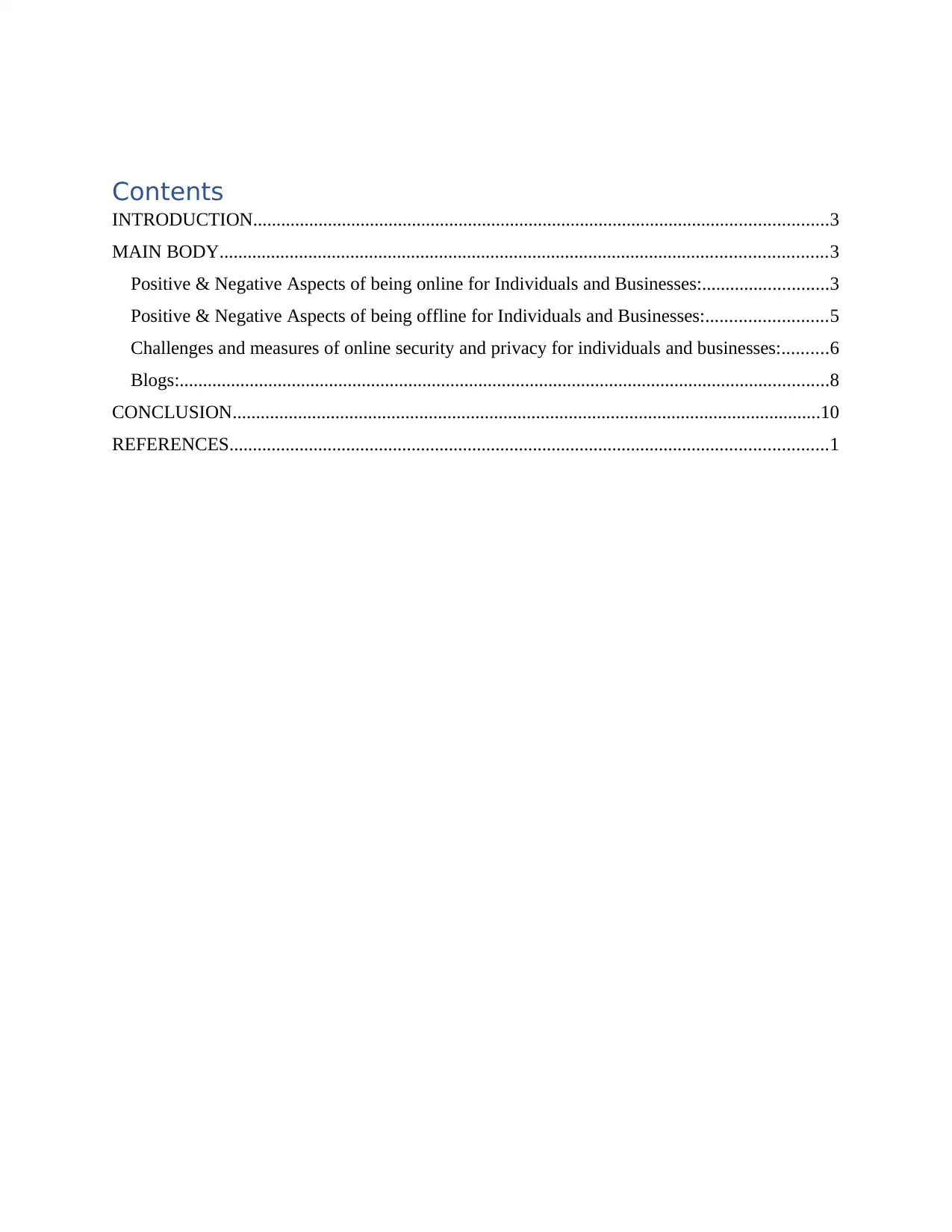
Contents
INTRODUCTION...........................................................................................................................3
MAIN BODY..................................................................................................................................3
Positive & Negative Aspects of being online for Individuals and Businesses:...........................3
Positive & Negative Aspects of being offline for Individuals and Businesses:..........................5
Challenges and measures of online security and privacy for individuals and businesses:..........6
Blogs:...........................................................................................................................................8
CONCLUSION..............................................................................................................................10
REFERENCES................................................................................................................................1
INTRODUCTION...........................................................................................................................3
MAIN BODY..................................................................................................................................3
Positive & Negative Aspects of being online for Individuals and Businesses:...........................3
Positive & Negative Aspects of being offline for Individuals and Businesses:..........................5
Challenges and measures of online security and privacy for individuals and businesses:..........6
Blogs:...........................................................................................................................................8
CONCLUSION..............................................................................................................................10
REFERENCES................................................................................................................................1
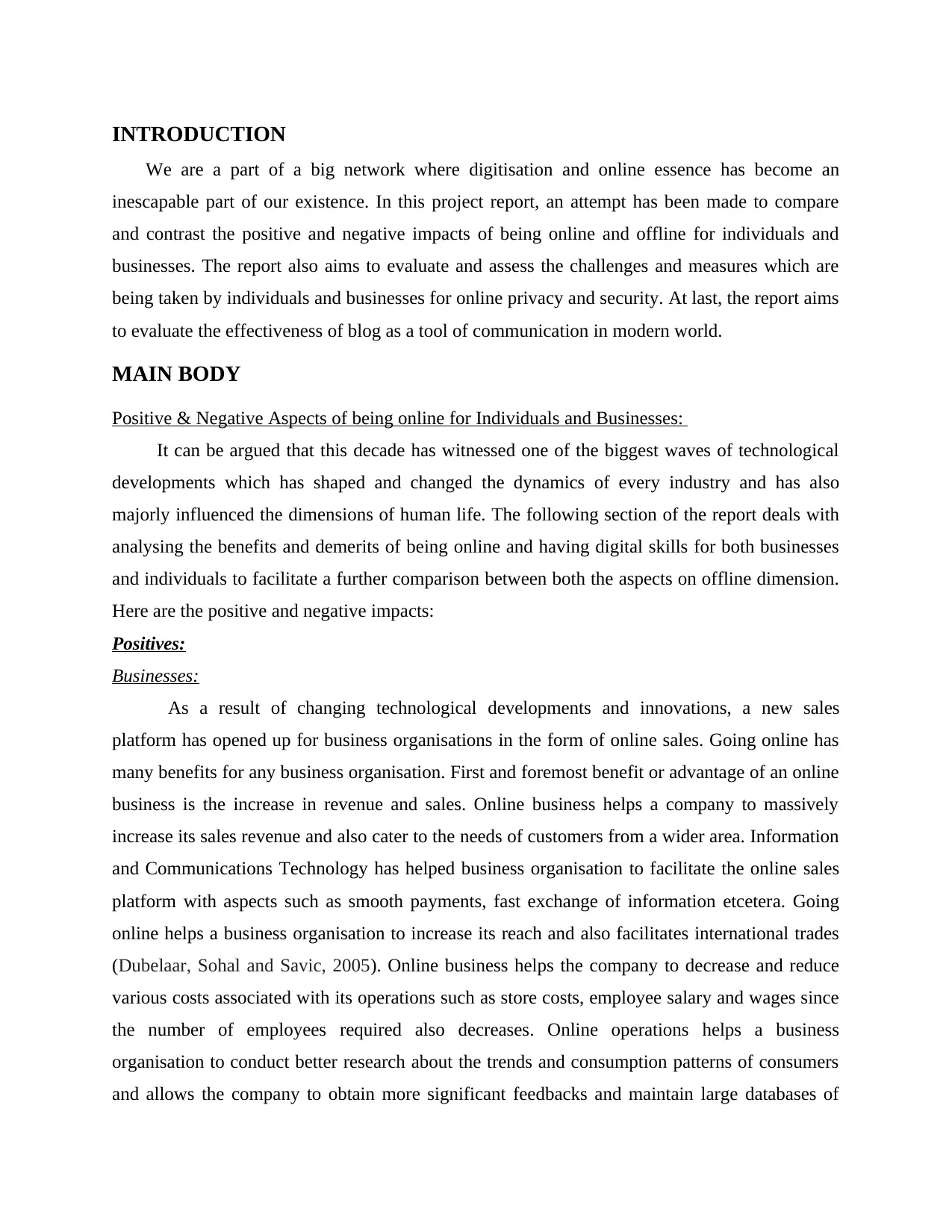
INTRODUCTION
We are a part of a big network where digitisation and online essence has become an
inescapable part of our existence. In this project report, an attempt has been made to compare
and contrast the positive and negative impacts of being online and offline for individuals and
businesses. The report also aims to evaluate and assess the challenges and measures which are
being taken by individuals and businesses for online privacy and security. At last, the report aims
to evaluate the effectiveness of blog as a tool of communication in modern world.
MAIN BODY
Positive & Negative Aspects of being online for Individuals and Businesses:
It can be argued that this decade has witnessed one of the biggest waves of technological
developments which has shaped and changed the dynamics of every industry and has also
majorly influenced the dimensions of human life. The following section of the report deals with
analysing the benefits and demerits of being online and having digital skills for both businesses
and individuals to facilitate a further comparison between both the aspects on offline dimension.
Here are the positive and negative impacts:
Positives:
Businesses:
As a result of changing technological developments and innovations, a new sales
platform has opened up for business organisations in the form of online sales. Going online has
many benefits for any business organisation. First and foremost benefit or advantage of an online
business is the increase in revenue and sales. Online business helps a company to massively
increase its sales revenue and also cater to the needs of customers from a wider area. Information
and Communications Technology has helped business organisation to facilitate the online sales
platform with aspects such as smooth payments, fast exchange of information etcetera. Going
online helps a business organisation to increase its reach and also facilitates international trades
(Dubelaar, Sohal and Savic, 2005). Online business helps the company to decrease and reduce
various costs associated with its operations such as store costs, employee salary and wages since
the number of employees required also decreases. Online operations helps a business
organisation to conduct better research about the trends and consumption patterns of consumers
and allows the company to obtain more significant feedbacks and maintain large databases of
We are a part of a big network where digitisation and online essence has become an
inescapable part of our existence. In this project report, an attempt has been made to compare
and contrast the positive and negative impacts of being online and offline for individuals and
businesses. The report also aims to evaluate and assess the challenges and measures which are
being taken by individuals and businesses for online privacy and security. At last, the report aims
to evaluate the effectiveness of blog as a tool of communication in modern world.
MAIN BODY
Positive & Negative Aspects of being online for Individuals and Businesses:
It can be argued that this decade has witnessed one of the biggest waves of technological
developments which has shaped and changed the dynamics of every industry and has also
majorly influenced the dimensions of human life. The following section of the report deals with
analysing the benefits and demerits of being online and having digital skills for both businesses
and individuals to facilitate a further comparison between both the aspects on offline dimension.
Here are the positive and negative impacts:
Positives:
Businesses:
As a result of changing technological developments and innovations, a new sales
platform has opened up for business organisations in the form of online sales. Going online has
many benefits for any business organisation. First and foremost benefit or advantage of an online
business is the increase in revenue and sales. Online business helps a company to massively
increase its sales revenue and also cater to the needs of customers from a wider area. Information
and Communications Technology has helped business organisation to facilitate the online sales
platform with aspects such as smooth payments, fast exchange of information etcetera. Going
online helps a business organisation to increase its reach and also facilitates international trades
(Dubelaar, Sohal and Savic, 2005). Online business helps the company to decrease and reduce
various costs associated with its operations such as store costs, employee salary and wages since
the number of employees required also decreases. Online operations helps a business
organisation to conduct better research about the trends and consumption patterns of consumers
and allows the company to obtain more significant feedbacks and maintain large databases of
⊘ This is a preview!⊘
Do you want full access?
Subscribe today to unlock all pages.

Trusted by 1+ million students worldwide
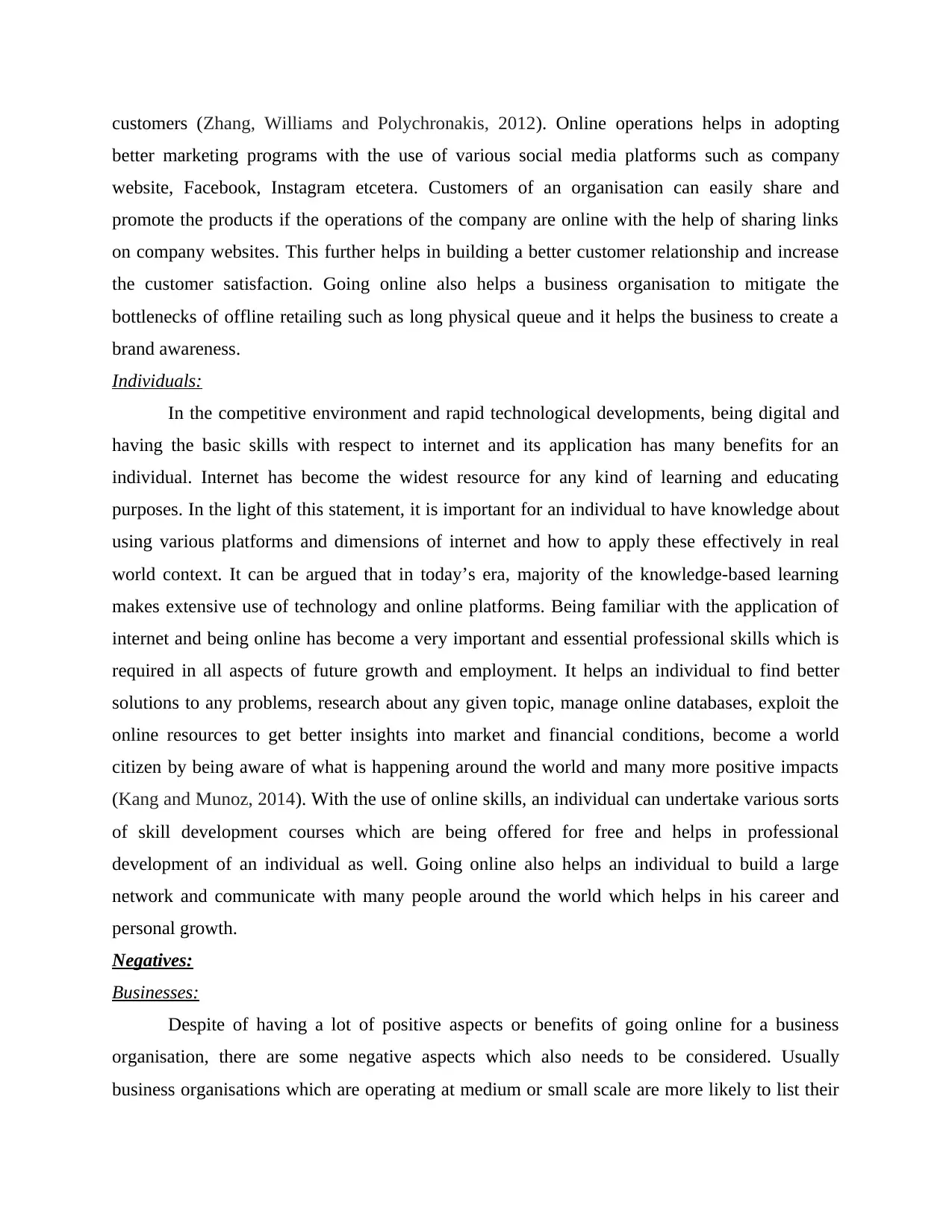
customers (Zhang, Williams and Polychronakis, 2012). Online operations helps in adopting
better marketing programs with the use of various social media platforms such as company
website, Facebook, Instagram etcetera. Customers of an organisation can easily share and
promote the products if the operations of the company are online with the help of sharing links
on company websites. This further helps in building a better customer relationship and increase
the customer satisfaction. Going online also helps a business organisation to mitigate the
bottlenecks of offline retailing such as long physical queue and it helps the business to create a
brand awareness.
Individuals:
In the competitive environment and rapid technological developments, being digital and
having the basic skills with respect to internet and its application has many benefits for an
individual. Internet has become the widest resource for any kind of learning and educating
purposes. In the light of this statement, it is important for an individual to have knowledge about
using various platforms and dimensions of internet and how to apply these effectively in real
world context. It can be argued that in today’s era, majority of the knowledge-based learning
makes extensive use of technology and online platforms. Being familiar with the application of
internet and being online has become a very important and essential professional skills which is
required in all aspects of future growth and employment. It helps an individual to find better
solutions to any problems, research about any given topic, manage online databases, exploit the
online resources to get better insights into market and financial conditions, become a world
citizen by being aware of what is happening around the world and many more positive impacts
(Kang and Munoz, 2014). With the use of online skills, an individual can undertake various sorts
of skill development courses which are being offered for free and helps in professional
development of an individual as well. Going online also helps an individual to build a large
network and communicate with many people around the world which helps in his career and
personal growth.
Negatives:
Businesses:
Despite of having a lot of positive aspects or benefits of going online for a business
organisation, there are some negative aspects which also needs to be considered. Usually
business organisations which are operating at medium or small scale are more likely to list their
better marketing programs with the use of various social media platforms such as company
website, Facebook, Instagram etcetera. Customers of an organisation can easily share and
promote the products if the operations of the company are online with the help of sharing links
on company websites. This further helps in building a better customer relationship and increase
the customer satisfaction. Going online also helps a business organisation to mitigate the
bottlenecks of offline retailing such as long physical queue and it helps the business to create a
brand awareness.
Individuals:
In the competitive environment and rapid technological developments, being digital and
having the basic skills with respect to internet and its application has many benefits for an
individual. Internet has become the widest resource for any kind of learning and educating
purposes. In the light of this statement, it is important for an individual to have knowledge about
using various platforms and dimensions of internet and how to apply these effectively in real
world context. It can be argued that in today’s era, majority of the knowledge-based learning
makes extensive use of technology and online platforms. Being familiar with the application of
internet and being online has become a very important and essential professional skills which is
required in all aspects of future growth and employment. It helps an individual to find better
solutions to any problems, research about any given topic, manage online databases, exploit the
online resources to get better insights into market and financial conditions, become a world
citizen by being aware of what is happening around the world and many more positive impacts
(Kang and Munoz, 2014). With the use of online skills, an individual can undertake various sorts
of skill development courses which are being offered for free and helps in professional
development of an individual as well. Going online also helps an individual to build a large
network and communicate with many people around the world which helps in his career and
personal growth.
Negatives:
Businesses:
Despite of having a lot of positive aspects or benefits of going online for a business
organisation, there are some negative aspects which also needs to be considered. Usually
business organisations which are operating at medium or small scale are more likely to list their
Paraphrase This Document
Need a fresh take? Get an instant paraphrase of this document with our AI Paraphraser
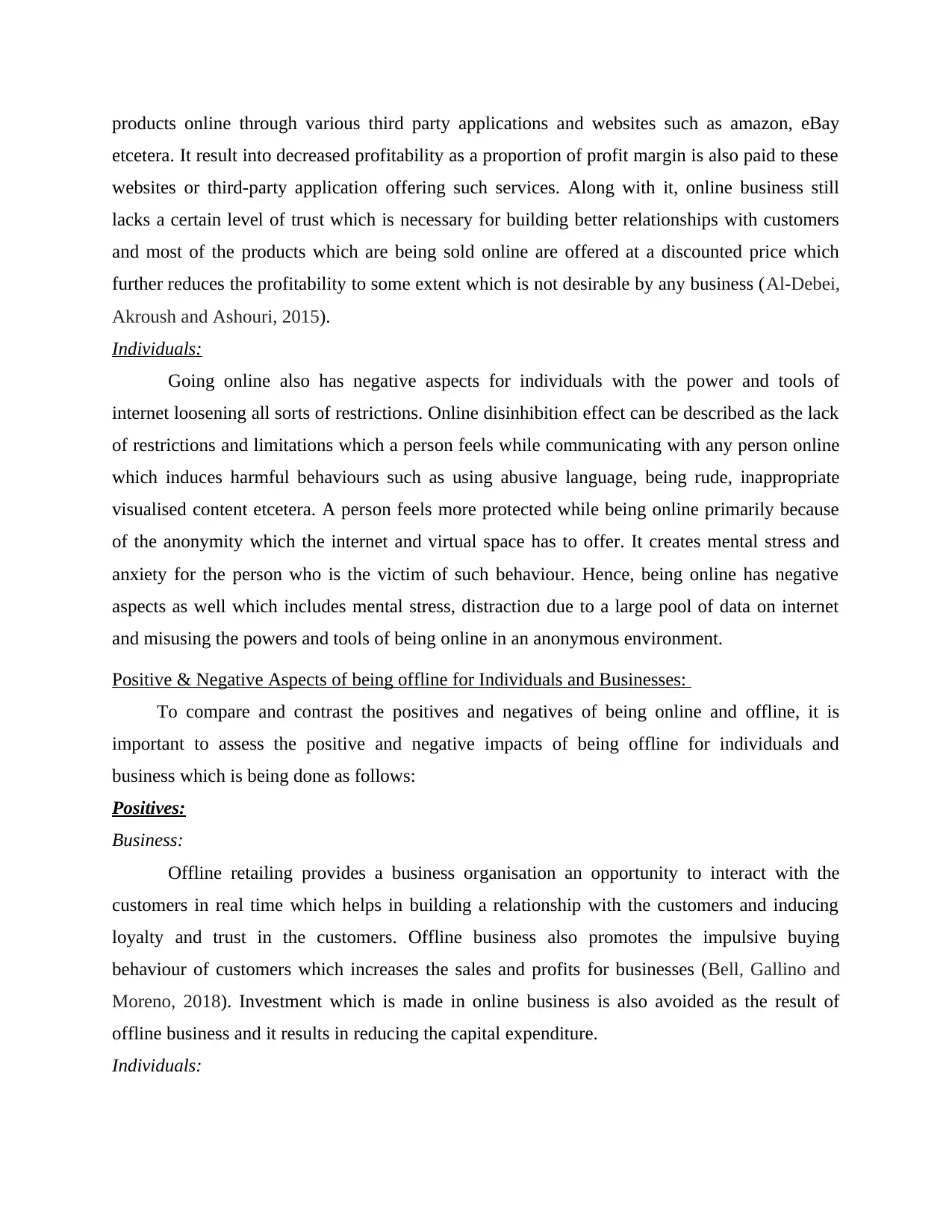
products online through various third party applications and websites such as amazon, eBay
etcetera. It result into decreased profitability as a proportion of profit margin is also paid to these
websites or third-party application offering such services. Along with it, online business still
lacks a certain level of trust which is necessary for building better relationships with customers
and most of the products which are being sold online are offered at a discounted price which
further reduces the profitability to some extent which is not desirable by any business (Al-Debei,
Akroush and Ashouri, 2015).
Individuals:
Going online also has negative aspects for individuals with the power and tools of
internet loosening all sorts of restrictions. Online disinhibition effect can be described as the lack
of restrictions and limitations which a person feels while communicating with any person online
which induces harmful behaviours such as using abusive language, being rude, inappropriate
visualised content etcetera. A person feels more protected while being online primarily because
of the anonymity which the internet and virtual space has to offer. It creates mental stress and
anxiety for the person who is the victim of such behaviour. Hence, being online has negative
aspects as well which includes mental stress, distraction due to a large pool of data on internet
and misusing the powers and tools of being online in an anonymous environment.
Positive & Negative Aspects of being offline for Individuals and Businesses:
To compare and contrast the positives and negatives of being online and offline, it is
important to assess the positive and negative impacts of being offline for individuals and
business which is being done as follows:
Positives:
Business:
Offline retailing provides a business organisation an opportunity to interact with the
customers in real time which helps in building a relationship with the customers and inducing
loyalty and trust in the customers. Offline business also promotes the impulsive buying
behaviour of customers which increases the sales and profits for businesses (Bell, Gallino and
Moreno, 2018). Investment which is made in online business is also avoided as the result of
offline business and it results in reducing the capital expenditure.
Individuals:
etcetera. It result into decreased profitability as a proportion of profit margin is also paid to these
websites or third-party application offering such services. Along with it, online business still
lacks a certain level of trust which is necessary for building better relationships with customers
and most of the products which are being sold online are offered at a discounted price which
further reduces the profitability to some extent which is not desirable by any business (Al-Debei,
Akroush and Ashouri, 2015).
Individuals:
Going online also has negative aspects for individuals with the power and tools of
internet loosening all sorts of restrictions. Online disinhibition effect can be described as the lack
of restrictions and limitations which a person feels while communicating with any person online
which induces harmful behaviours such as using abusive language, being rude, inappropriate
visualised content etcetera. A person feels more protected while being online primarily because
of the anonymity which the internet and virtual space has to offer. It creates mental stress and
anxiety for the person who is the victim of such behaviour. Hence, being online has negative
aspects as well which includes mental stress, distraction due to a large pool of data on internet
and misusing the powers and tools of being online in an anonymous environment.
Positive & Negative Aspects of being offline for Individuals and Businesses:
To compare and contrast the positives and negatives of being online and offline, it is
important to assess the positive and negative impacts of being offline for individuals and
business which is being done as follows:
Positives:
Business:
Offline retailing provides a business organisation an opportunity to interact with the
customers in real time which helps in building a relationship with the customers and inducing
loyalty and trust in the customers. Offline business also promotes the impulsive buying
behaviour of customers which increases the sales and profits for businesses (Bell, Gallino and
Moreno, 2018). Investment which is made in online business is also avoided as the result of
offline business and it results in reducing the capital expenditure.
Individuals:

Positives of being offline for an individual includes better quality of social relations and
community relationships. It also ensures the privacy of the individual. Data thefts and online
privacy is a heavily controversial topic and it is being argued that privacy on internet is a myth
which increases the risks associated with online surfing. Moreover, being offline helps an
individual to focus on his overall development which includes mental as well physical qualities
and live without mental stress and disorders.
Negatives:
Business:
Offline business creates a limit on the number of products or the stock which can be
managed by a business organisation to offer to its potential customers. It also increases the
expenses in the form of store expenses and higher salary and wages being provided to the
employees (Ram and Sun, 2020). Business which are entirely offline find it very difficult to offer
its products and services to customers from a wide area and stem the future growth and
development prospects of the organisation.
Individuals:
Negatives of being offline includes creating a limitation on the wide potential of skill and
quality development which is essential for an individual with respect to his career and
professional growth. Learning opportunities reduces for an individual as a result of his lack of
digital and online presence. Network building and communication also suffers as a result of
offline being which is very essential for the professional as well as personal growth of an
individual (Watthananon and Yoosuka, 2014).
On the basis of above comparison and contrast between the negative and positive aspects of
being online and offline for an individual and businesses, it can be interpreted that positive
aspects of being online certainly outweighs its negative aspects and similarly negative aspects of
being offline outweighs its positive impacts. Hence, having both online and offline existence is
necessary for individuals and businesses and it is also imperative that security and privacy
measures are followed by individuals and businesses in case of being online.
Challenges and measures of online security and privacy for individuals and businesses:
Challenges:
Exponential growth of data: The rate of increase in data is exponential which makes it
difficult to be managed. Poor systems of data handling and inefficiency to manage such large
community relationships. It also ensures the privacy of the individual. Data thefts and online
privacy is a heavily controversial topic and it is being argued that privacy on internet is a myth
which increases the risks associated with online surfing. Moreover, being offline helps an
individual to focus on his overall development which includes mental as well physical qualities
and live without mental stress and disorders.
Negatives:
Business:
Offline business creates a limit on the number of products or the stock which can be
managed by a business organisation to offer to its potential customers. It also increases the
expenses in the form of store expenses and higher salary and wages being provided to the
employees (Ram and Sun, 2020). Business which are entirely offline find it very difficult to offer
its products and services to customers from a wide area and stem the future growth and
development prospects of the organisation.
Individuals:
Negatives of being offline includes creating a limitation on the wide potential of skill and
quality development which is essential for an individual with respect to his career and
professional growth. Learning opportunities reduces for an individual as a result of his lack of
digital and online presence. Network building and communication also suffers as a result of
offline being which is very essential for the professional as well as personal growth of an
individual (Watthananon and Yoosuka, 2014).
On the basis of above comparison and contrast between the negative and positive aspects of
being online and offline for an individual and businesses, it can be interpreted that positive
aspects of being online certainly outweighs its negative aspects and similarly negative aspects of
being offline outweighs its positive impacts. Hence, having both online and offline existence is
necessary for individuals and businesses and it is also imperative that security and privacy
measures are followed by individuals and businesses in case of being online.
Challenges and measures of online security and privacy for individuals and businesses:
Challenges:
Exponential growth of data: The rate of increase in data is exponential which makes it
difficult to be managed. Poor systems of data handling and inefficiency to manage such large
⊘ This is a preview!⊘
Do you want full access?
Subscribe today to unlock all pages.

Trusted by 1+ million students worldwide

data bases leads to a potential risk to the privacy of the individuals (Salomon, 2012). The
emerging issue of data theft and privacy breach has become a major concern of consumers and
so the businesses face an enhanced responsibility of dealing with such issues.
Cost of maintaining data privacy: Companies bear a large sum on building data-privacy
systems, and the penalties if charged legally for data theft are insanely high. This is one of the
major challenge with respect to online privacy and security for individuals and business
organisations.
Human-errors and lack of knowledge: An uninformed user also makes it easier for third
parties to steal data or hack weak passwords. It has been argued by many security analysts that
lack of knowledge and likelihood of common human errors as a result is the biggest challenge
which is being faced with respect to online privacy and security (Chasaki and Mansour, 2015). It
is likely for a person who has access to privileged accounts that he may fall for any of the scams
and might indulge in browsing websites which don’t fall under acceptable uses and create a risk
for data thefts and privacy breach.
Payments and money transfers: With the rise and increase in online retailing, one of the
biggest challenge which creates a hindrance is the number of people who get cheated or become
the victim of fake payments and online transfers which leads to money loss for the customers. A
lot of consumers still don’t have necessary education for taking prevention in case of online
money frauds and thefts.
Measures:
Training and education: Business organisation are taking measures and efforts to educate
and train the members of the company with respect to potential data threats and online security
breaches and how these can be avoided (Kitchin, 2016). It helps in mitigating the possibilities or
likelihood of any human error leading to a risk of privacy and security while being online.
Using VPN: Individuals are recommended to use Virtual Private Networks while
browsing internet using shared source of data connection which ensures their privacy and helps
in reducing the threat to data breach. Moreover, since public networks don’t have any traffic
encryption structure, individuals are advised not to share any tender details such as credit card
credentials, passwords and pins etcetera when they are not on private network.
Checking privacy settings and using more secure passwords: As a measure to take
responsibility and minimise the threat of online data breach, individuals are using more secure
emerging issue of data theft and privacy breach has become a major concern of consumers and
so the businesses face an enhanced responsibility of dealing with such issues.
Cost of maintaining data privacy: Companies bear a large sum on building data-privacy
systems, and the penalties if charged legally for data theft are insanely high. This is one of the
major challenge with respect to online privacy and security for individuals and business
organisations.
Human-errors and lack of knowledge: An uninformed user also makes it easier for third
parties to steal data or hack weak passwords. It has been argued by many security analysts that
lack of knowledge and likelihood of common human errors as a result is the biggest challenge
which is being faced with respect to online privacy and security (Chasaki and Mansour, 2015). It
is likely for a person who has access to privileged accounts that he may fall for any of the scams
and might indulge in browsing websites which don’t fall under acceptable uses and create a risk
for data thefts and privacy breach.
Payments and money transfers: With the rise and increase in online retailing, one of the
biggest challenge which creates a hindrance is the number of people who get cheated or become
the victim of fake payments and online transfers which leads to money loss for the customers. A
lot of consumers still don’t have necessary education for taking prevention in case of online
money frauds and thefts.
Measures:
Training and education: Business organisation are taking measures and efforts to educate
and train the members of the company with respect to potential data threats and online security
breaches and how these can be avoided (Kitchin, 2016). It helps in mitigating the possibilities or
likelihood of any human error leading to a risk of privacy and security while being online.
Using VPN: Individuals are recommended to use Virtual Private Networks while
browsing internet using shared source of data connection which ensures their privacy and helps
in reducing the threat to data breach. Moreover, since public networks don’t have any traffic
encryption structure, individuals are advised not to share any tender details such as credit card
credentials, passwords and pins etcetera when they are not on private network.
Checking privacy settings and using more secure passwords: As a measure to take
responsibility and minimise the threat of online data breach, individuals are using more secure
Paraphrase This Document
Need a fresh take? Get an instant paraphrase of this document with our AI Paraphraser
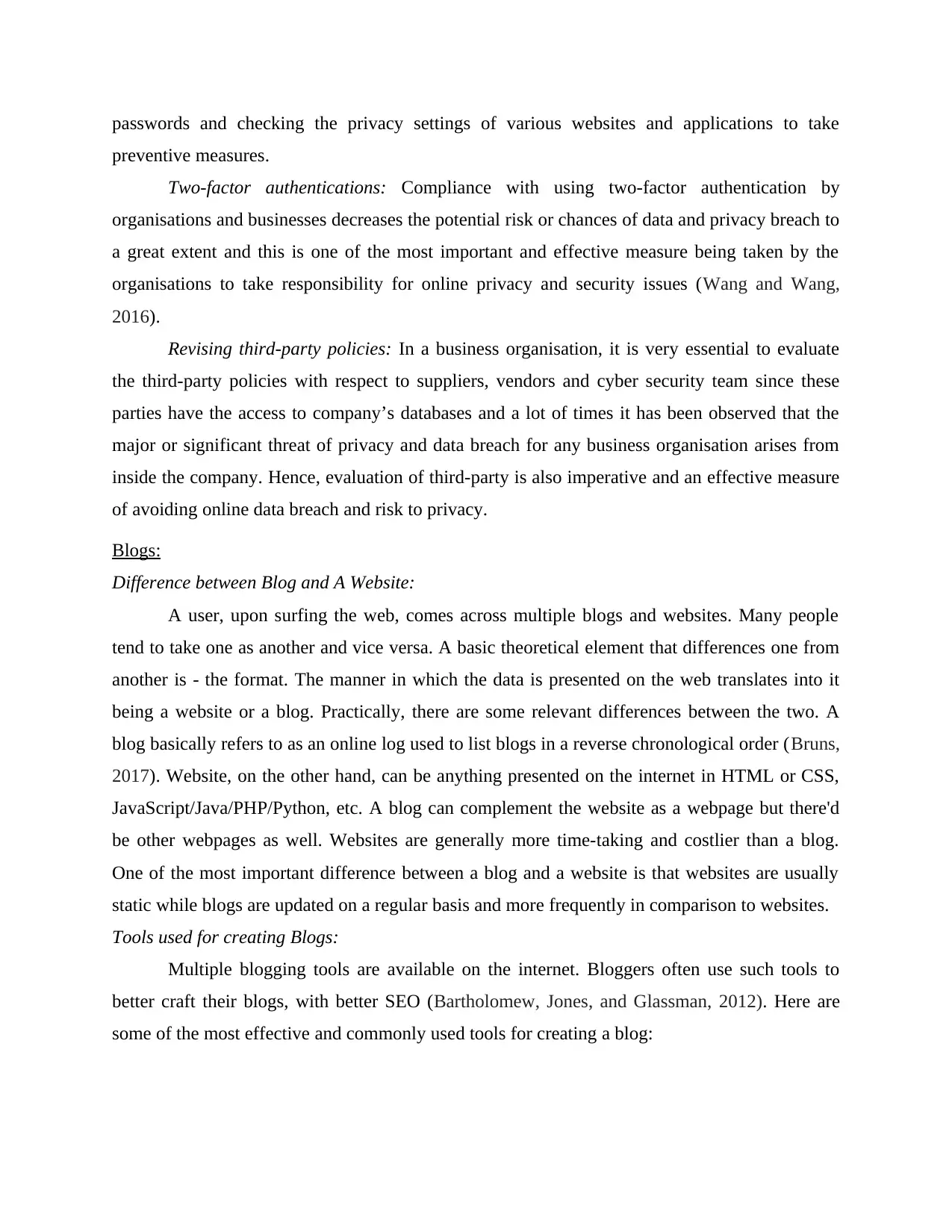
passwords and checking the privacy settings of various websites and applications to take
preventive measures.
Two-factor authentications: Compliance with using two-factor authentication by
organisations and businesses decreases the potential risk or chances of data and privacy breach to
a great extent and this is one of the most important and effective measure being taken by the
organisations to take responsibility for online privacy and security issues (Wang and Wang,
2016).
Revising third-party policies: In a business organisation, it is very essential to evaluate
the third-party policies with respect to suppliers, vendors and cyber security team since these
parties have the access to company’s databases and a lot of times it has been observed that the
major or significant threat of privacy and data breach for any business organisation arises from
inside the company. Hence, evaluation of third-party is also imperative and an effective measure
of avoiding online data breach and risk to privacy.
Blogs:
Difference between Blog and A Website:
A user, upon surfing the web, comes across multiple blogs and websites. Many people
tend to take one as another and vice versa. A basic theoretical element that differences one from
another is - the format. The manner in which the data is presented on the web translates into it
being a website or a blog. Practically, there are some relevant differences between the two. A
blog basically refers to as an online log used to list blogs in a reverse chronological order (Bruns,
2017). Website, on the other hand, can be anything presented on the internet in HTML or CSS,
JavaScript/Java/PHP/Python, etc. A blog can complement the website as a webpage but there'd
be other webpages as well. Websites are generally more time-taking and costlier than a blog.
One of the most important difference between a blog and a website is that websites are usually
static while blogs are updated on a regular basis and more frequently in comparison to websites.
Tools used for creating Blogs:
Multiple blogging tools are available on the internet. Bloggers often use such tools to
better craft their blogs, with better SEO (Bartholomew, Jones, and Glassman, 2012). Here are
some of the most effective and commonly used tools for creating a blog:
preventive measures.
Two-factor authentications: Compliance with using two-factor authentication by
organisations and businesses decreases the potential risk or chances of data and privacy breach to
a great extent and this is one of the most important and effective measure being taken by the
organisations to take responsibility for online privacy and security issues (Wang and Wang,
2016).
Revising third-party policies: In a business organisation, it is very essential to evaluate
the third-party policies with respect to suppliers, vendors and cyber security team since these
parties have the access to company’s databases and a lot of times it has been observed that the
major or significant threat of privacy and data breach for any business organisation arises from
inside the company. Hence, evaluation of third-party is also imperative and an effective measure
of avoiding online data breach and risk to privacy.
Blogs:
Difference between Blog and A Website:
A user, upon surfing the web, comes across multiple blogs and websites. Many people
tend to take one as another and vice versa. A basic theoretical element that differences one from
another is - the format. The manner in which the data is presented on the web translates into it
being a website or a blog. Practically, there are some relevant differences between the two. A
blog basically refers to as an online log used to list blogs in a reverse chronological order (Bruns,
2017). Website, on the other hand, can be anything presented on the internet in HTML or CSS,
JavaScript/Java/PHP/Python, etc. A blog can complement the website as a webpage but there'd
be other webpages as well. Websites are generally more time-taking and costlier than a blog.
One of the most important difference between a blog and a website is that websites are usually
static while blogs are updated on a regular basis and more frequently in comparison to websites.
Tools used for creating Blogs:
Multiple blogging tools are available on the internet. Bloggers often use such tools to
better craft their blogs, with better SEO (Bartholomew, Jones, and Glassman, 2012). Here are
some of the most effective and commonly used tools for creating a blog:
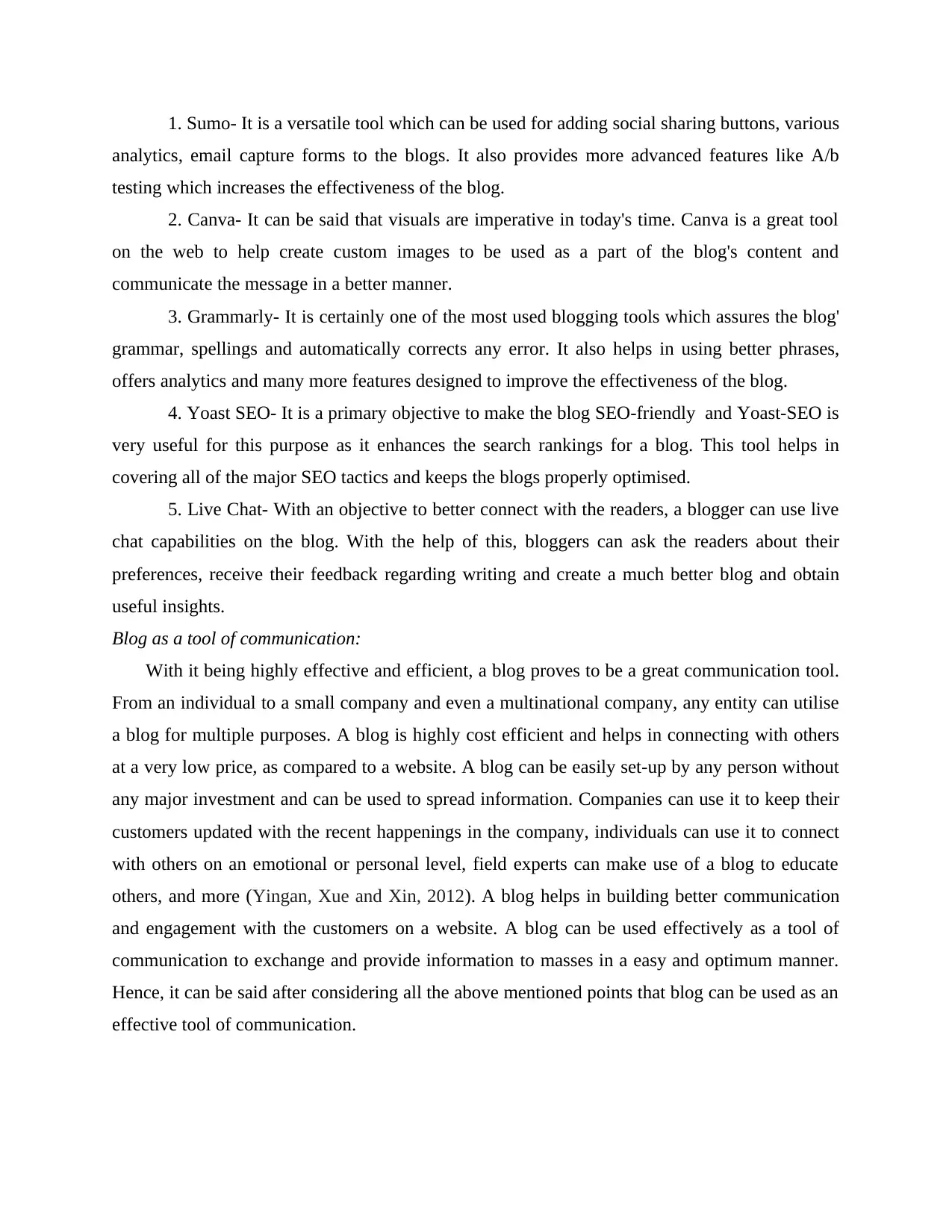
1. Sumo- It is a versatile tool which can be used for adding social sharing buttons, various
analytics, email capture forms to the blogs. It also provides more advanced features like A/b
testing which increases the effectiveness of the blog.
2. Canva- It can be said that visuals are imperative in today's time. Canva is a great tool
on the web to help create custom images to be used as a part of the blog's content and
communicate the message in a better manner.
3. Grammarly- It is certainly one of the most used blogging tools which assures the blog'
grammar, spellings and automatically corrects any error. It also helps in using better phrases,
offers analytics and many more features designed to improve the effectiveness of the blog.
4. Yoast SEO- It is a primary objective to make the blog SEO-friendly and Yoast-SEO is
very useful for this purpose as it enhances the search rankings for a blog. This tool helps in
covering all of the major SEO tactics and keeps the blogs properly optimised.
5. Live Chat- With an objective to better connect with the readers, a blogger can use live
chat capabilities on the blog. With the help of this, bloggers can ask the readers about their
preferences, receive their feedback regarding writing and create a much better blog and obtain
useful insights.
Blog as a tool of communication:
With it being highly effective and efficient, a blog proves to be a great communication tool.
From an individual to a small company and even a multinational company, any entity can utilise
a blog for multiple purposes. A blog is highly cost efficient and helps in connecting with others
at a very low price, as compared to a website. A blog can be easily set-up by any person without
any major investment and can be used to spread information. Companies can use it to keep their
customers updated with the recent happenings in the company, individuals can use it to connect
with others on an emotional or personal level, field experts can make use of a blog to educate
others, and more (Yingan, Xue and Xin, 2012). A blog helps in building better communication
and engagement with the customers on a website. A blog can be used effectively as a tool of
communication to exchange and provide information to masses in a easy and optimum manner.
Hence, it can be said after considering all the above mentioned points that blog can be used as an
effective tool of communication.
analytics, email capture forms to the blogs. It also provides more advanced features like A/b
testing which increases the effectiveness of the blog.
2. Canva- It can be said that visuals are imperative in today's time. Canva is a great tool
on the web to help create custom images to be used as a part of the blog's content and
communicate the message in a better manner.
3. Grammarly- It is certainly one of the most used blogging tools which assures the blog'
grammar, spellings and automatically corrects any error. It also helps in using better phrases,
offers analytics and many more features designed to improve the effectiveness of the blog.
4. Yoast SEO- It is a primary objective to make the blog SEO-friendly and Yoast-SEO is
very useful for this purpose as it enhances the search rankings for a blog. This tool helps in
covering all of the major SEO tactics and keeps the blogs properly optimised.
5. Live Chat- With an objective to better connect with the readers, a blogger can use live
chat capabilities on the blog. With the help of this, bloggers can ask the readers about their
preferences, receive their feedback regarding writing and create a much better blog and obtain
useful insights.
Blog as a tool of communication:
With it being highly effective and efficient, a blog proves to be a great communication tool.
From an individual to a small company and even a multinational company, any entity can utilise
a blog for multiple purposes. A blog is highly cost efficient and helps in connecting with others
at a very low price, as compared to a website. A blog can be easily set-up by any person without
any major investment and can be used to spread information. Companies can use it to keep their
customers updated with the recent happenings in the company, individuals can use it to connect
with others on an emotional or personal level, field experts can make use of a blog to educate
others, and more (Yingan, Xue and Xin, 2012). A blog helps in building better communication
and engagement with the customers on a website. A blog can be used effectively as a tool of
communication to exchange and provide information to masses in a easy and optimum manner.
Hence, it can be said after considering all the above mentioned points that blog can be used as an
effective tool of communication.
⊘ This is a preview!⊘
Do you want full access?
Subscribe today to unlock all pages.

Trusted by 1+ million students worldwide
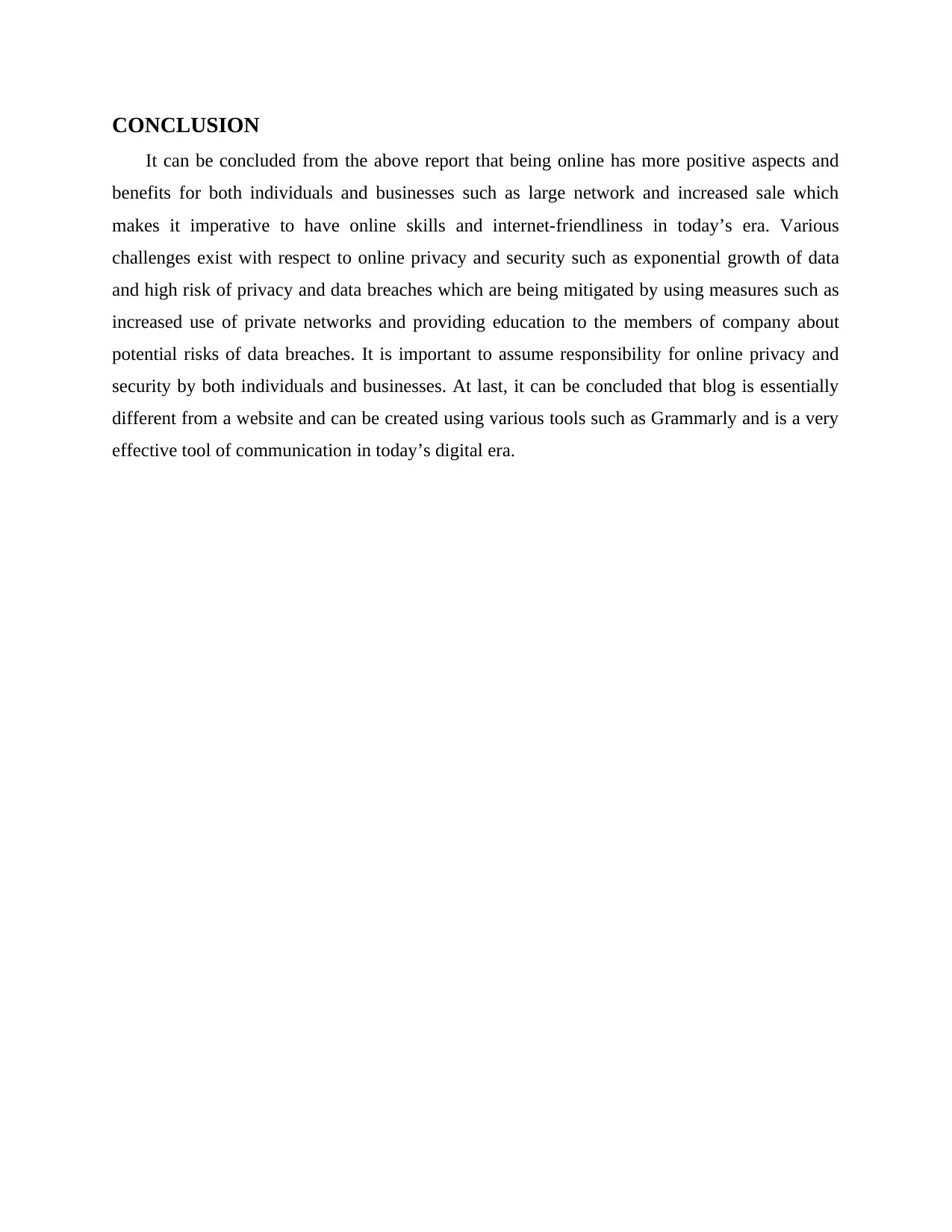
CONCLUSION
It can be concluded from the above report that being online has more positive aspects and
benefits for both individuals and businesses such as large network and increased sale which
makes it imperative to have online skills and internet-friendliness in today’s era. Various
challenges exist with respect to online privacy and security such as exponential growth of data
and high risk of privacy and data breaches which are being mitigated by using measures such as
increased use of private networks and providing education to the members of company about
potential risks of data breaches. It is important to assume responsibility for online privacy and
security by both individuals and businesses. At last, it can be concluded that blog is essentially
different from a website and can be created using various tools such as Grammarly and is a very
effective tool of communication in today’s digital era.
It can be concluded from the above report that being online has more positive aspects and
benefits for both individuals and businesses such as large network and increased sale which
makes it imperative to have online skills and internet-friendliness in today’s era. Various
challenges exist with respect to online privacy and security such as exponential growth of data
and high risk of privacy and data breaches which are being mitigated by using measures such as
increased use of private networks and providing education to the members of company about
potential risks of data breaches. It is important to assume responsibility for online privacy and
security by both individuals and businesses. At last, it can be concluded that blog is essentially
different from a website and can be created using various tools such as Grammarly and is a very
effective tool of communication in today’s digital era.
Paraphrase This Document
Need a fresh take? Get an instant paraphrase of this document with our AI Paraphraser
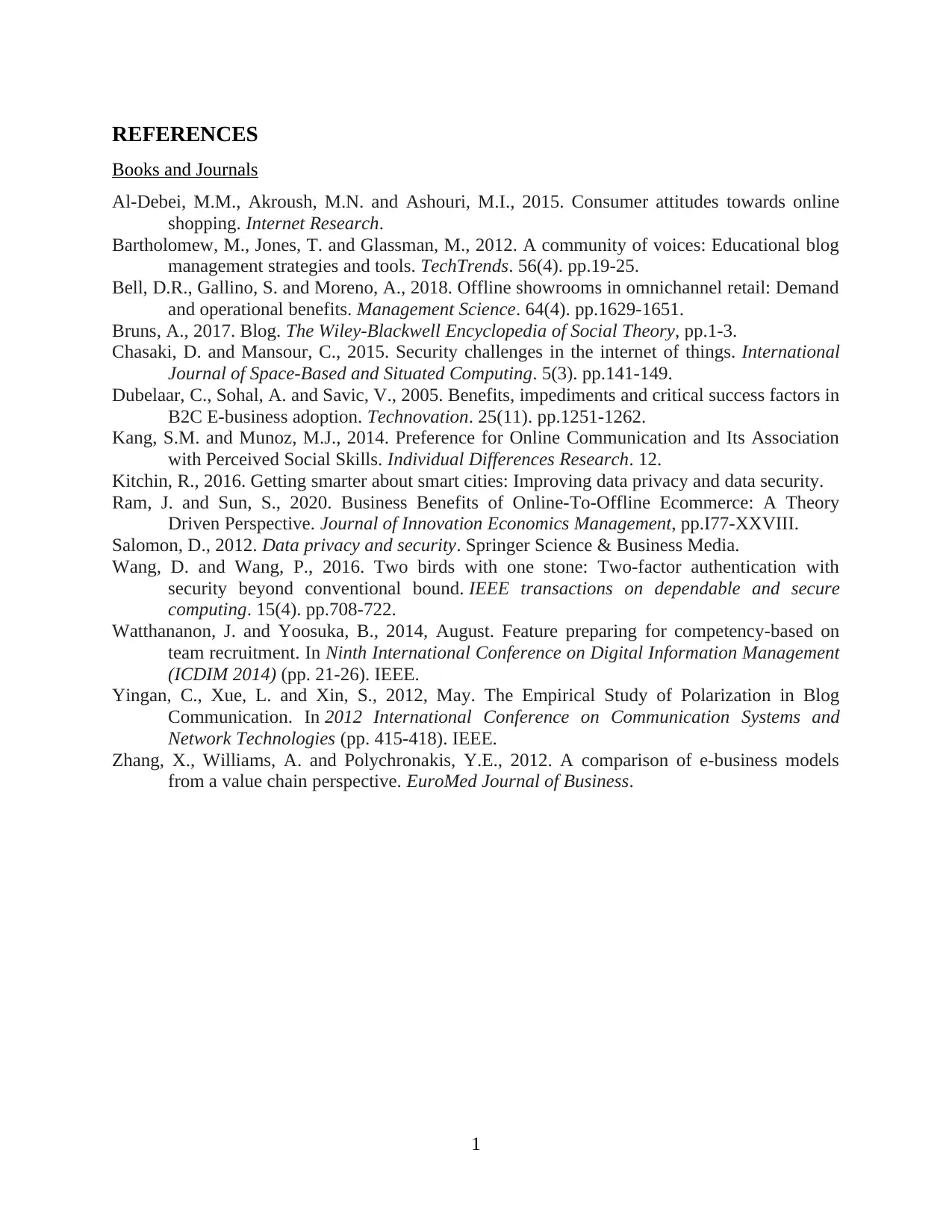
REFERENCES
Books and Journals
Al-Debei, M.M., Akroush, M.N. and Ashouri, M.I., 2015. Consumer attitudes towards online
shopping. Internet Research.
Bartholomew, M., Jones, T. and Glassman, M., 2012. A community of voices: Educational blog
management strategies and tools. TechTrends. 56(4). pp.19-25.
Bell, D.R., Gallino, S. and Moreno, A., 2018. Offline showrooms in omnichannel retail: Demand
and operational benefits. Management Science. 64(4). pp.1629-1651.
Bruns, A., 2017. Blog. The Wiley‐Blackwell Encyclopedia of Social Theory, pp.1-3.
Chasaki, D. and Mansour, C., 2015. Security challenges in the internet of things. International
Journal of Space-Based and Situated Computing. 5(3). pp.141-149.
Dubelaar, C., Sohal, A. and Savic, V., 2005. Benefits, impediments and critical success factors in
B2C E-business adoption. Technovation. 25(11). pp.1251-1262.
Kang, S.M. and Munoz, M.J., 2014. Preference for Online Communication and Its Association
with Perceived Social Skills. Individual Differences Research. 12.
Kitchin, R., 2016. Getting smarter about smart cities: Improving data privacy and data security.
Ram, J. and Sun, S., 2020. Business Benefits of Online-To-Offline Ecommerce: A Theory
Driven Perspective. Journal of Innovation Economics Management, pp.I77-XXVIII.
Salomon, D., 2012. Data privacy and security. Springer Science & Business Media.
Wang, D. and Wang, P., 2016. Two birds with one stone: Two-factor authentication with
security beyond conventional bound. IEEE transactions on dependable and secure
computing. 15(4). pp.708-722.
Watthananon, J. and Yoosuka, B., 2014, August. Feature preparing for competency-based on
team recruitment. In Ninth International Conference on Digital Information Management
(ICDIM 2014) (pp. 21-26). IEEE.
Yingan, C., Xue, L. and Xin, S., 2012, May. The Empirical Study of Polarization in Blog
Communication. In 2012 International Conference on Communication Systems and
Network Technologies (pp. 415-418). IEEE.
Zhang, X., Williams, A. and Polychronakis, Y.E., 2012. A comparison of e‐business models
from a value chain perspective. EuroMed Journal of Business.
1
Books and Journals
Al-Debei, M.M., Akroush, M.N. and Ashouri, M.I., 2015. Consumer attitudes towards online
shopping. Internet Research.
Bartholomew, M., Jones, T. and Glassman, M., 2012. A community of voices: Educational blog
management strategies and tools. TechTrends. 56(4). pp.19-25.
Bell, D.R., Gallino, S. and Moreno, A., 2018. Offline showrooms in omnichannel retail: Demand
and operational benefits. Management Science. 64(4). pp.1629-1651.
Bruns, A., 2017. Blog. The Wiley‐Blackwell Encyclopedia of Social Theory, pp.1-3.
Chasaki, D. and Mansour, C., 2015. Security challenges in the internet of things. International
Journal of Space-Based and Situated Computing. 5(3). pp.141-149.
Dubelaar, C., Sohal, A. and Savic, V., 2005. Benefits, impediments and critical success factors in
B2C E-business adoption. Technovation. 25(11). pp.1251-1262.
Kang, S.M. and Munoz, M.J., 2014. Preference for Online Communication and Its Association
with Perceived Social Skills. Individual Differences Research. 12.
Kitchin, R., 2016. Getting smarter about smart cities: Improving data privacy and data security.
Ram, J. and Sun, S., 2020. Business Benefits of Online-To-Offline Ecommerce: A Theory
Driven Perspective. Journal of Innovation Economics Management, pp.I77-XXVIII.
Salomon, D., 2012. Data privacy and security. Springer Science & Business Media.
Wang, D. and Wang, P., 2016. Two birds with one stone: Two-factor authentication with
security beyond conventional bound. IEEE transactions on dependable and secure
computing. 15(4). pp.708-722.
Watthananon, J. and Yoosuka, B., 2014, August. Feature preparing for competency-based on
team recruitment. In Ninth International Conference on Digital Information Management
(ICDIM 2014) (pp. 21-26). IEEE.
Yingan, C., Xue, L. and Xin, S., 2012, May. The Empirical Study of Polarization in Blog
Communication. In 2012 International Conference on Communication Systems and
Network Technologies (pp. 415-418). IEEE.
Zhang, X., Williams, A. and Polychronakis, Y.E., 2012. A comparison of e‐business models
from a value chain perspective. EuroMed Journal of Business.
1
1 out of 11
Related Documents
Your All-in-One AI-Powered Toolkit for Academic Success.
+13062052269
info@desklib.com
Available 24*7 on WhatsApp / Email
![[object Object]](/_next/static/media/star-bottom.7253800d.svg)
Unlock your academic potential
Copyright © 2020–2025 A2Z Services. All Rights Reserved. Developed and managed by ZUCOL.




